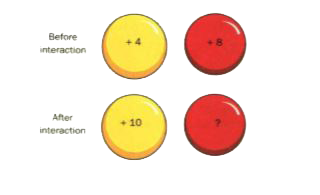Similar charges _______________ each other whereas opposite charges ____________ each other.
To solve the question, we need to fill in the blanks with the correct terms related to the behavior of electric charges.
1. Understanding the behavior of charges:
- Charges can be classified as similar (like charges) or opposite (unlike charges).
- Similar charges are those that have the same type (e.g., both positive or both negative).
- Opposite charges are those that have different types (one positive and one negative).
2. Identifying the behavior of similar charges:
- When two similar charges are brought close to each other, they will push away from each other. This is known as repulsion.
3. Identifying the behavior of opposite charges:
- When two opposite charges are brought close to each other, they will pull towards each other. This is known as attraction.
4. Filling in the blanks:
- The first blank should be filled with "repel" because similar charges repel each other.
- The second blank should be filled with "attract" because opposite charges attract each other.
Thus, the completed sentence is:
"Similar charges repel each other whereas opposite charges attract each other."
- Charges can be classified as similar (like charges) or opposite (unlike charges).
- Similar charges are those that have the same type (e.g., both positive or both negative).
- Opposite charges are those that have different types (one positive and one negative).
- When two similar charges are brought close to each other, they will push away from each other. This is known as repulsion.
- When two opposite charges are brought close to each other, they will pull towards each other. This is known as attraction.
- The first blank should be filled with "repel" because similar charges repel each other.
- The second blank should be filled with "attract" because opposite charges attract each other.
"Similar charges repel each other whereas opposite charges attract each other."
Similar Questions
Similar charges attract each other. ____________
View Solution(A) : If two beams of protons move parallel to each other in same direction then these beams repel each other.
(R) : Like charges repel while opposite charges attract each other.
View SolutionTwo bar magnets are placed close to each other with their opposite poles facing each other. In absence of other forces, the magnets are pulled towards each other and their kinetc energy increases. Does it contradict our earlier knowledge that magnetic forces cannot do any work and hence cannot increase kinetic energy of a system?
View SolutionDescribe an experiment to show :
like charges repel each other.
View SolutionFigure D shows two spheres that initially have +4 and +8 positive charge. After an interaction (which could simply be that they touch each other), the yellow sphere has +10 positive charge, and the red sphere has an unknown quantity of charge. Use the law of conservation of charge to find the final charge on the red sphere.

View SolutionA charges Q is placed at each of the two opposite corners of a square. A charge q is placed to each of the other two corners. If the resultant force on each charge q is zero, then
View SolutionA charges Q is placed at each of the two opposite corners of a square. A charge q is placed to each of the other two corners. If the resultant force on each charge q is zero, then
View SolutionA charge Q is place at each of the opposite corners of a square. A charge q is placed at each of the other two corners. If the net electrical force on Q is zero, then Q/q equals:
View SolutionDescribe an experiment to show :
Unlike charges attract each other.
View SolutionTwo infinite linear charges are placed parallel to each other at a distance 0.1m from each other. If the linear charge density on each is 5μC/m, then the force acting on a unit length of each linear charge will be:
View Solution